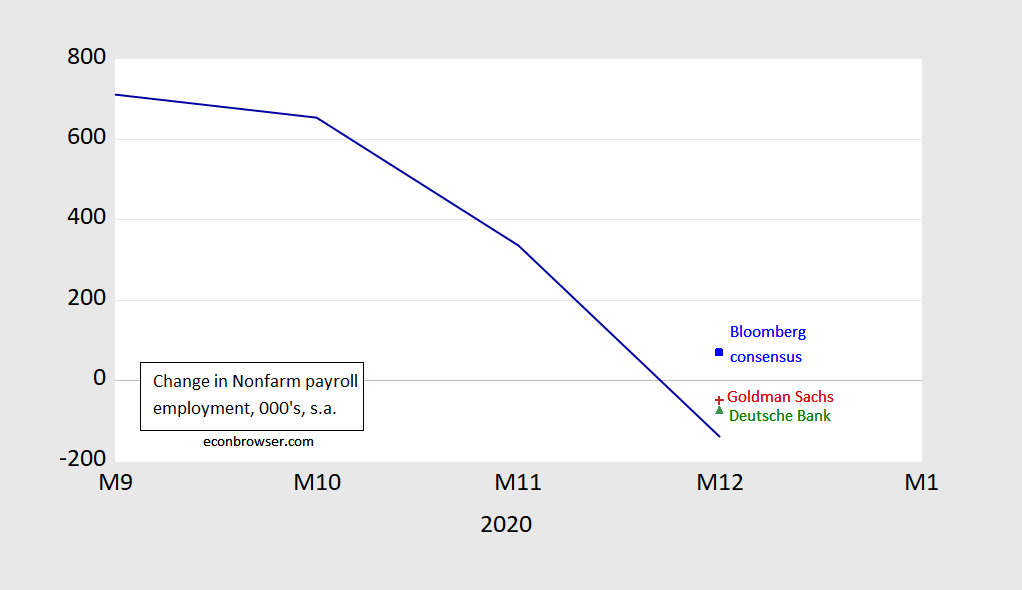Nonfarm payroll (NFP) employment down 100 thousand, contra +81 Bloomberg consensus, even worse than GS and DB.
Figure 1: Change in nonfarm payroll employment, in thousands, s.a. (blue), Bloomberg consensus (light blue square), Goldman Sachs (red +), and Deutsche Bank (green triangle). Source: BLS, Bloomberg, Goldman Sachs, and Deutsche Bank all as of 1/7, and author’s calculations.
The change in net employment is below the negative Goldman Sachs and Deutsche Bank forecasts discussed yesterday (but higher than the implied levels assuming the changes applied to November levels).
Key variables tracked by NBER Business Cycle Dating Committee (BCDC) continue to show increasingly negative indications, as discussed on the 4th.
Figure 2: Nonfarm payroll employment (dark blue), industrial production (red), personal income excluding transfers in Ch.2012$ (green), manufacturing and trade sales in Ch.2012$ (black), and monthly GDP in Ch.2012$ (pink), all log normalized to 2020M02=0. Source: BLS, Federal Reserve, BEA, via FRED, IHS Markit (nee Macroeconomic Advisers) (1/4/2021 release), NBER, and author’s calculations.


Nonfarm payroll employment may be down but the household survey is up. And Nobel Prize winning economist Lawrence Kudlow would point out that the household survey is the better measure – but only when it gives better political news. I hear he has a paper on it submitted to the American Economic Review.
I guess I’m “easily entertained” tonight, that one made me laugh pretty good. Our judges say that’s a 4 and 1/2 stars comment (I’m taking off one half point because my bias of being in a good mood)
https://www.cepr.net/jobs-2021-01/
January 8, 2021
Pandemic-Caused Plunge in Restaurant Jobs Leads to First Job Loss Since April
By DEAN BAKER
The pain from the recession is heavily concentrated among the long-term unemployed.
The economy lost 140,000 jobs in December, all of which can be attributed to a plunge in restaurant employment of 372,000. Other sectors highly sensitive to the pandemic, such as hotels and recreation, also lost jobs. The unemployment rate and employment-to-population ratio (EPOP) were both unchanged at 6.7 percent and 57.4 percent, respectively.
The resurgence of the pandemic further heightened the two-track nature of this recession. Construction and manufacturing, two sectors normally hard hit in downturns, added 51,000 and 38,000 jobs, respectively. Employment in construction now stands 3.0 percent below its pre-pandemic level, while employment in manufacturing is 4.2 percent lower. Finance and insurance added 6,900 jobs in December. Employment is now 0.4 percent above its pre-pandemic level.
By contrast, the loss of 372,000 jobs put restaurant employment 19.9 percent below its February level. The hotel sector lost 23,600 jobs in the month, putting employment 31.8 percent below pre-pandemic levels. Employment in recreation and gambling is down by 30.6 percent, after losing 91,900 jobs in December.
Other big pandemic job losers are air transportation, down 23.4 percent from February; motion pictures, down 42.1 percent; and, sports and performing arts, down 39.3 percent. In December, air transportation added 2,800 jobs, while the motion picture sector lost 3,400 jobs, and the performing arts and sports lost 10,500 jobs.
Retail added 120,500 jobs in December, while health care added 38,800. Employment in these sectors is now down by 2.6 percent and 3.0 percent, respectively, from pre-pandemic levels. State and local government shed another 51,000 jobs in December. Employment in this sector is down by 7.0 percent, almost 1.4 million jobs, from the pre-pandemic level.
One growth area has been couriers, where there has been a rise in employment of 221,800 since February or 26.2 percent. A possible good omen in this report is a rise in temp employment of 67,600. This follows rises of 125,500 and 41,800 in the prior two months, which could mean more permanent hires in the months ahead.
There was little change in the length of the average work week, which stood at 34.7 hours in December. This is 0.4 hours longer than the year-ago level. This means that the reduction in labor demand is being met by laying off workers rather than reducing hours, making the pain from the recession more heavily concentrated among the unemployed….
It will be interesting to see how they handle the seasonal adjustment next month. No fun!
They (BLS staffers) “handle” seasonal adjustment the same way they always do – they will apply a well documented method of seasoanl adjustment: https://www.bls.gov/sae/seasonal-adjustment/
No ambiguity, no hanky-panky, no politics.
You may have made JohnH very unhappy. He really wants something that says the BLS are paid for political hacks (even though they have never been).
I didn’t mean to be mean…
There’s a TV program called “The Codebreaker” that’s going to be on 8pm central on PBS Monday night. HEADS UP!!!!!!!! looks like it’s gonna be a good one. BTW, I was watching Yamiche Alcindor Host “Washington Week in Review” tonight. Honestly I have always kind of disliked her~~~but I gotta say tonight she did a superb job of hosting the show.
I’m struggling to find an upside to much of anything for a few months. It’s going to take a new administration at least that long to clean up messes, let alone do things like sort out vaccine logistics that are critical to improving the economy.
Just the start of what Biden America will look like.
Get used to it, you voted for this.
Just the start of what Biden America will look like.
Get used to it, you voted for this.